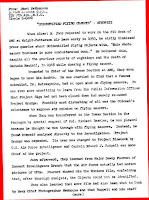
We recently completed an informal analysis of writer Francis Martin's script for "U.F.O." in these pages. Unfortunately, I was unable to locate Mr. Martin back in the seventies, even after contacting a few (mostly) California resources available at that time. Had the Internet been commonplace back then, I dare say the lost would have been found and Martin may well have offered a wealth of information about his role in the production.
However, the June 12, 1956 edition of what appears to be the Oshkosh Daily Northwestern Reporter carried an article entitled, "Ex-Oshkosh Man is Movie Script Writer," and we learn that Martin was born in Ashland, Wisconsin in 1900. The occasion for this article was his visit to Oshkosh whilst preparing scripts for a couple of unspecified TV documentaries. Of course, the other big news, duly noted in the newspaper article, was Martin's accomplishment of the movie script.
A veteran of both World Wars I and II, Martin actually experienced a very interesting career. He started as a dancer in Los Angeles nightclubs and began appearing in movies as a dancer and actor in the 1920s. By his own estimate, he had "a couple of hundred screen credits" before he began directing and writing scripts in 1926, and had been under contract with major studios such as Universal and Paramount. Martin proudly admitted turning out movie scripts for the likes of Bob Hope, Bing Crosby, Rudy Vallee, George Burns & Gracie Allen and W.C. Fields.
Fields was a favorite, and the two were close friends. While Martin described Fields as "a delightful and generous person," and one of the greatest entertainers ever, admittedly Fields could be difficult, often rewriting portions of script at the list minute, or resorting to ad libs and scrapping his lines altogether when the cameras rolled -- still, according to Martin, resulting in brilliant results, even if such antics angered other actors and studio executives.
The article's remaining paragraphs summarize Martin's new UFO movie with words of encouragement, and I would suspect that, when the film came to town, loyal Oshkosh and area residents congregated in neighborhood theaters to view the work of a native son.
(Credit: Barry Greenwood. Note -- I put a link up to Mr. Greenwood's revised Web site in the link list on my adjoining blog, http://robert-barrow.blogspot.com/ and his thoughtful analysis of UFO-related issues as a veteran researcher must not be missed.)
However, the June 12, 1956 edition of what appears to be the Oshkosh Daily Northwestern Reporter carried an article entitled, "Ex-Oshkosh Man is Movie Script Writer," and we learn that Martin was born in Ashland, Wisconsin in 1900. The occasion for this article was his visit to Oshkosh whilst preparing scripts for a couple of unspecified TV documentaries. Of course, the other big news, duly noted in the newspaper article, was Martin's accomplishment of the movie script.
A veteran of both World Wars I and II, Martin actually experienced a very interesting career. He started as a dancer in Los Angeles nightclubs and began appearing in movies as a dancer and actor in the 1920s. By his own estimate, he had "a couple of hundred screen credits" before he began directing and writing scripts in 1926, and had been under contract with major studios such as Universal and Paramount. Martin proudly admitted turning out movie scripts for the likes of Bob Hope, Bing Crosby, Rudy Vallee, George Burns & Gracie Allen and W.C. Fields.
Fields was a favorite, and the two were close friends. While Martin described Fields as "a delightful and generous person," and one of the greatest entertainers ever, admittedly Fields could be difficult, often rewriting portions of script at the list minute, or resorting to ad libs and scrapping his lines altogether when the cameras rolled -- still, according to Martin, resulting in brilliant results, even if such antics angered other actors and studio executives.
The article's remaining paragraphs summarize Martin's new UFO movie with words of encouragement, and I would suspect that, when the film came to town, loyal Oshkosh and area residents congregated in neighborhood theaters to view the work of a native son.
(Credit: Barry Greenwood. Note -- I put a link up to Mr. Greenwood's revised Web site in the link list on my adjoining blog, http://robert-barrow.blogspot.com/ and his thoughtful analysis of UFO-related issues as a veteran researcher must not be missed.)







